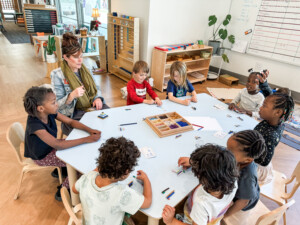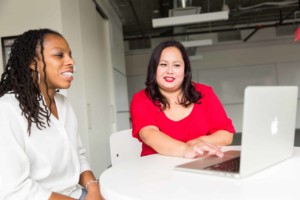12 Next Steps for Ed Leaders

We’ve been studying the employment landscape and the future of work in our #AskAboutAI series. It has led to a couple observations:
- The world is changing—fast. Work is dynamic and often gig (short assignment) or project-based. People live, learn, work, shop on platforms. Automation is reshaping the employment landscape. Everyone will live and work with smart machines–a big impact opportunity but the source of a lot of coming dislocation.
- Leadership is no longer a title. Leadership is a distributed function within an organization to create optimal learning environments for all stakeholders.
- Collective action builds community and drives results. Leaders facilitate conversations that result in a shared vision of a better future. They work with all community members towards common goals. Those who model working together with the community will also be modeling the social and emotional skills required to interact in society.
- Lifelong learning is key—for everyone. Given the speed of the innovation economy, every family, neighborhood, region and country needs to get smart fast (here’s 10 reasons).
The most promising schools, districts, and networks suggest 12 next steps for EdLeaders:
1. Master your mindset. Over the last decade Dweck, Duckworth, and Tough reminded us that a growth mindset matters. In addition to the importance of hard work, we think students need the opportunity to make stuff, to take initiative and work collaboratively.
In Smart Cities we outlined the formula: Innovation Mindset = Growth Mindset + Maker Mindset + Team Mindset. (Read about classroom strategies for building an innovation mindset).
If leaders want teachers and students to develop an innovation mindset, they should start by examining their own approach to the work. Ask some tough questions: Do I recognize effort as well as reward performance? Do I create room and incentives for initiative and risk-taking? Have I created a collaborative environment?
2. Name the theories in use. Clay Christensen said theories have experience, they define causality, they help human beings create agreements and move forward. But you only gain that benefit by naming the theories in use. Education is bounded by sedimentary layers of policy and practice that once had meaning but now form unexamined traditions. By being explicit about what’s going on, we have a shot at building a path forward.
Like the folks at the Christensen Institute, we see personalized learning as a grand unifying theory, one that acknowledges that different students have different needs at different times. There are two ways to create coherent personalized learning environments. The first is an enterprise approach—everybody across the system doing the same thing using the same systems. The other approach is a portfolio of schools, each with a unique model and customized supports. You can only create role and goal clarity for the people you work with if you’re clear about the theory in use.
3. Create an LX vision. EdLeaders have the opportunity to lead community conversations about what is possible. That starts with putting students, and their learning experiences (LX), first. For hundreds of years schools have been organized around the needs of the adults and the enactment of a common curriculum. It’s now possible to customize a sequence of experiences for every student (See 15 dimensions of next-gen LX).
Hold community conversations about parenting for powerful learning. Our book, Smart Parents is based on a vision of student-centered learning: personalized, competency-based, anytime anywhere, with kids driving their own learning.
4. Expose new school models. What’s different between a struggling school and a next-gen school? Everything! New school models that incorporate lessons learned and new technology have different structures, schedules, and systems. You and your team need to study new models. Time for a road trip or at least a staff study project. We think school visits are the best form of professional learning.
The most influential group packaging promising strategies into new and transformed school grants is Next Generation Learning Challenges. Each of the 130+ teams embrace high expectations for college and career readiness and personalized learning. They are approaching their work in a way that is scalable and sustainable. Supporting new and transformed schools, the NGLC operates through regional funds. NewSchools Venture Fund and 4.0 Schools incubate teams planning new schools supports.
5. Embrace broader aims. It’s clear that broader aims of student success, including mindset, self-management and relational skills, are widely recognized as important to success in life (See KnowledgeWorks On Redefining Readiness).
These hard to measure skills and dispositions require broader feedback systems than traditional standardized testing. Two examples worth noting include:
- NAF, a national network of career academies, has a great system for tracking college and career readiness, check out their work skills rubric.
- DSST is the best high poverty STEM network but CEO Bill Kurtz considers it a values-first organization. Students receive feedback on each character dimension every six weeks.
The Aspen Commission on Social, Emotional and Academic Development is developing a common lexicon and better measures for SEL competencies (See podcast with chair Tim Shriver).
The MyWays framework from NGLC is the best representation of what grads should know and be able to do
To move past a narrow focus on test prep, EdLeaders create community conversations about what grads should know and be able to do. EdLeader21 published Profile of a Graduate, which includes a gallery of examples and a roadmap.
With clear commitments to equity and excellence and embracing the paradox of clarity and openness, EdLeaders should take every opportunity to describe a hopeful future where students and teachers benefit from personalized learning. It’s particularly helpful to be quite specific about the kinds of experiences you’d like to see more of (see #3).
EdLeaders need to be conversation leaders and agreement crafters. When things are this dynamic, a sequence of temporary agreements that keep a school community moving is the best case scenario.
6. Work in networks. Personalized learning is promising but challenging. It pays to work together in loose networks (PLC, Networked Improvement Groups, grantee cohorts, or regional efforts like Remake Learning in Pittsburgh), voluntary networks (New Tech Network, NAF, EL Education), curriculum networks (AVID, PLTW) or in managed networks (charter management organizations or districts that operate like one).
With the platform revolution, more schools will find or create networks that support their learning model. Platform networks (which most are becoming) share a learning model, a platform (or bundle of tools) and professional learning options (below).
Platform networks may benefit from a “network effect” as the network grows and gains features and gets smarter.
7. Model next-gen learning. Want to see more next generation learning? It starts with modeling the way, being authentic, vulnerable, and connecting with others.
Start modeling the way by exposing your routines for trend monitoring, sensemaking, and learning new things, including successes and challenges. Share your lessons in staff conversations and in social media. Blogging can be a great way to model clarity of convictions and openness to new pathways.
8. Personalize professional learning. Ditch the old boring school-wide PD. As discussed in Preparing Leaders for Deeper Learning, educators should have the same kind of learning experiences as students–blended, personalized, and competency-based.
Platforms like Bloomboard make it easy to build an individual learning plan linked to quality learning experiences and earn microcredentials that chart each educator’s progress.
9. Use projects to distribute leadership and manage change. System heads can improve or transform their organizations by managing change as a system of projects. By distributing project leadership to emerging leaders across the organization, you can develop talent while you develop the organization. Justin Reich called it Projects That Learn.
Diverse work experiences build breath. You can’t rely solely on formal preparation or what’s provided by an organization. Take responsibility for your own path. Draw a bigger sphere of influence. Apply for or create learning experiences and seek out coherent leadership preparation.
10. Get lean. Education will need to stay nimble in terms of desired outcomes as well as practices, structures and communication. In most states, there is no new money coming to K-12 education and in many areas enrollments are flat or declining–not a pleasant combination for school district administrators. It pays to be a competitive, coherent, and creative 21st Century school district.
The following are at least a dozen school district functional areas where there are usually opportunities to boost efficiency and effectiveness.
11. Be well. Managing a school is a big job. Orchestrating a transformation agenda requires what seems like superhuman powers. The first part of the solution is to distribute leadership. The second part is to take care of yourself. Build daily wellness habits. If you want healthy staff and students, modeling starts with you.
12. Stick around. Real equity producing progress takes time, a broad web of leadership sustained over a decade. Stick around and see the fruits of your hard work.
For more see:
- Preparing to Lead in a Project-Based World
- 5 Lessons on Impact Leadership (Podcast with Rob Waldron, Curriculum Associates)
- Superintendent Leadership For PBL (Podcast with Mario Basora, Yellow Springs Schools)








Android robo
Education should increase the effectiveness of education as well as in educational practices, practices, structures and communication, And develop daily health habits. Modeling starts with you if you want healthy staff and students.